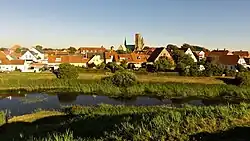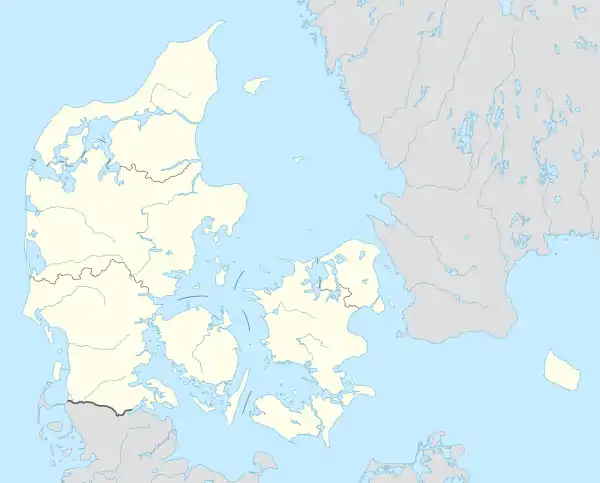Ribe | |
|---|---|
Town | |
 Ribe seen from Riberhus | |
 Coat of arms | |
 Ribe Location in Denmark .svg.png.webp) Ribe Ribe (Region of Southern Denmark) | |
| Coordinates: 55°19′42″N 08°45′44″E / 55.32833°N 8.76222°E | |
| Country | Denmark |
| Region | Southern Denmark (Syddanmark) |
| Municipality | Esbjerg |
| Area | |
| • Urban | 7.3 km2 (2.8 sq mi) |
| Population (2023) | |
| • Urban | 8,365 |
| • Urban density | 1,100/km2 (3,000/sq mi) |
| • Gender [1] | 3,994 males and 4,371 females |
| Demonym | Ripenser |
| Time zone | UTC+1 (CET) |
| • Summer (DST) | UTC+2 (CEST) |
| Postal code | DK-6760 Ribe |
| Website | www |
Ribe (Danish pronunciation: [ˈʁiːpə]) is a town in south-west Jutland, Denmark, with a population of 8,365 (2023).[2][3] It is the seat of the Diocese of Ribe covering southwestern Jutland. Until 1 January 2007, Ribe was the seat of both a surrounding municipality and county. It is now part of the enlarged Esbjerg Municipality in the Region of Southern Denmark. It is the oldest town in Denmark.[4]
History

The town was a center of commercial activity in the early 8th century, and this may have originated with royal influence. Coins may have been struck there in 720. Whichever king was involved in the digging of the Kanhave Canal may have been involved in the establishment of Ribe also. Trade contacts were mostly with Frisia and England.[5] Of the over 300 sceatas found in Denmark, 216 come from in or around Ribe, most of them the Wodan type, and these were likely minted in Ribe in the early eighth century.[6] The Ancient Diocese of Ribe was established in 948 with the consecration of Leofdag of Ribe as its first bishop.[7]
Early in the ninth century a 2-meter wide ditch (a demarcation rather than a fortification) was dug around the town, enclosing a 12-hectare area. Later that century the ditch was replaced by a moat, 6 to 7 meters wide. Archeological evidence shows Ribe was "an active and impressive market place" in the eighth and ninth centuries, and again at the end of the eleventh century, but there is little evidence from the period in between; the town may have dwindled or even disappeared.[6]
When archbishop Ansgar set out to christianize Scandinavia, he requested (in about 860) of King Horik II of Denmark that the first Scandinavian church be built in Ribe, which at the time was one of the most important trade cities in Scandinavia. However, the presence in Ribe of a bishop, and thus a cathedral, can only be confirmed from the year 948. Recent archaeological excavations in Ribe, however, have led to the discovery of between 2,000 and 3,000 Christian graves. They have been dated to the ninth century, indicating that a large Christian community was already living peacefully together with the Vikings at the time.[8] Excavations conducted between 2008 and 2012 have also revealed more details of the original church built by Ansgar.[9]
Construction on the Ribe Cathedral started in 1150, on top of an earlier church, most probably Ansgar's church, built in 860.[10] The Treaty of Ribe was proclaimed in 1460. Being located in a large region of low-lying marshland, Ribe has repeatedly been hit by storm floods, the most devastating being the Burchardi flood of 1634. The marks after this flood can still be seen on the cathedral's walls and is also marked as the top point on a flood pillar in the town.[11][12] Today Ribe, along with much of the Wadden Sea coastline, is protected by dykes.
The Catholic diocese was dissolved in 1536 during the Reformation; it was succeeded by the Diocese of Ribe, governed by the newly established protestant Church of Denmark.
On 1 January 2007, the Municipality of Ribe ceased to exist as it merged with the municipalities of Esbjerg and Bramming, now forming the new municipality of Esbjerg.
Notable sites
- Ribe Cathedral
- Ribe Kunstmuseum - an art museum
- Riberhus - a castle (only some ruins remain, along with the water moat) likely built by Eric V of Denmark in the 1200s
- Wadden Sea Centre - a museum and visitors center for the Wadden Sea National Park, located a few km outside Ribe
Notable people



The arts
- Anders Bording (1619–1677), poet
- Kristen Feilberg (1839 in Vester Vedsted – 1919), photographer of the peoples and landscapes of Sumatra and Singapore
- Jacob Riis (1849–1914), an American immigrant photographer, wrote How the Other Half Lives
- Bodil Hauschildt (1861–1951), photographer
- J. Bodewalt Lampe (1869–1929), American composer, arranger, performer
- Jens Olsen (1872–1945), a clockmaker and locksmith
- Astrid Noack (1888–1954), a Danish sculptor
- Rued Langgaard (1893–1952) a late-Romantic composer and organist at Ribe Cathedral
- Kjeld Abell (1901–1961), playwright, screenwriter and theatrical designer
- Børge Ring (1921–2018), animated short film writer, director and animator
- Annemette Kure Andersen (born 1969), poet and literary editor
- Per Vers (born 1976), rapper[13]
Politicians, clergy, and officials
- Valdemar II of Denmark (1170–1241), King of Denmark[14]
- Hans Tausen (1494–1561), leader of the Reformation in Denmark,[15] Bishop of Ribe 1542–1562.
- Peder Palladius (1503–1560), theologian, priest and bishop
- Maren Spliid (c.1600–1641), victim of the persecution of witches
- Hans Schack, 2nd Count of Schackenborg (1676 in Ribe – 1719), nobleman
- Hans Adolf Brorson (1694–1764), Danish Pietist clergyman and hymn writer
- Friderich Christian Hager (1756–1795), colonial commander and governor of the Danish Gold Coast
- Elisabeth Dons Christensen (born 1944), theologian, bishop of the Diocese of Ribe 2003–2014
- Holger K. Nielsen (born 1950), former leader of the Socialist People's Party
Science and business
- Vibeke Jensdatter (1638–1709), merchant
- Emil Christian Hansen (1842–1909), brewmaster and mycologist
- Cathrine Horsbøl (1872–1947), furniture designer
- Jens Rasmussen (1926–2018), professor
- Erik Hansen (1927–2016), architect
- Stefan Sahl (1976–present), Copywriter[16]
Sport
- John Lauridsen (born 1959), footballer
- Martin Rauschenberg (born 1992), footballer
- Mikael Uhre (born 1994), footballer
Education
The town of Ribe has a long history as a center of learning. The cathedral school (Ribe Katedralskole) has its roots in the Latin School of Ribe, dating back to at least 1145, when the bishop officially handed over the chapter's school.[17] The school provided religious education of priests and clergymen up until 1805 and is nowadays a gymnasium (Danish high school). Ribe Katedralskole celebrated its 850th anniversary in 1995, and is the oldest continuously existing school in Scandinavia.
Schools
- Ribe Katedralskole
- The State College of Education in Ribe (Teacher Training College), part of the University College of West Jutland
- Ribe Business College
- VUC (Adult Education Center)
Demographics
The following table shows the population of Ribe. Data from before the 18th century are estimates, the rest are taken from the official census.
|
|
|
|
|
Twin cities and towns
|
|
See also
References
- ↑ BY1: Population 1. January by urban areas, age and sex The Mobile Statbank from Statistics Denmark
- ↑ BY3: Population 1. January by urban areas, area and population density The Mobile Statbank from Statistics Denmark
- ↑ "Statistikbanken". www.statbank.dk.
- ↑ "Ribe is the oldest town in the Nordic countries".
- ↑ McKitterick, Rosamond; Reuter, Timothy, eds. (1995). The New Cambridge Medieval History. Cambridge UP. p. 205. ISBN 9780521362924.
- 1 2 Feveile, Claus (2008). "Series X and Coin Circulation in Ribe". In Abramson, Tony (ed.). Two Decades of Discovery. Studies in Early Medieval Coinage: Two Decades of Discovery. Vol. 1. Boydell Press. pp. 53–68. ISBN 9781843833710.
- ↑ Taylor, Arthur (1914). "Ancient See of Ribe in Denmark (Jutland)". The Catholic Encyclopedia. Vol. 16. New York: The Encyclopedia Press – via New Advent.
- ↑ Lisbeth Quass (24 July 2014). "Danskere var kristne længe før Harald Blåtand´". Berlingske (in Danish).
- ↑ "Danskere var kristne længe før Harald Blåtand". Kristeligt Dagblad (in Danish). 23 July 2014. Retrieved 26 July 2014.
- ↑ Robinson, Charles H. (1921). Rimbert: Life of Anskar, the Apostle of the North, 801–865, translated from the Vita Anskarii by Bishop Rimbert his fellow missionary and successor. London: Society for Promoting Christian Knowledge. Retrieved 26 September 2022.
- ↑ "De 5 største stormfloder i Vadehavet". Naturstyrelsen (Denmark's Ministry of Environment). Retrieved 18 October 2023.
- ↑ "Historiske stormfloder i Nordsøen og Danmark". Danish Meteorological Institute. 3 July 2018. Retrieved 18 October 2023.
- ↑ Vers, Per (13 January 2016). "En brobygger-bromance". Per Vers (in Danish). Retrieved 21 September 2021.
- ↑ Bain, Robert Nisbet (1911). . Encyclopædia Britannica. Vol. 27 (11th ed.). pp. 841–842.
- ↑ . Encyclopædia Britannica. Vol. 26 (11th ed.). 1911.
- ↑ "Stefan Sahl – Creative Circle".
- ↑ "Ribe Katedralskole" (in Danish). The Danish National Archives. Retrieved 12 July 2015.
Sources
- The New Cambridge Medieval History. Cambridge University Press, 1995. ISBN 0-521-36292-X.
 This article incorporates text from a publication now in the public domain: Herbermann, Charles, ed. (1913). "Ancient See of Ribe". Catholic Encyclopedia. New York: Robert Appleton Company. s:Catholic Encyclopedia (1913)/Ancient See of Ribe in Denmark (Jutland)
This article incorporates text from a publication now in the public domain: Herbermann, Charles, ed. (1913). "Ancient See of Ribe". Catholic Encyclopedia. New York: Robert Appleton Company. s:Catholic Encyclopedia (1913)/Ancient See of Ribe in Denmark (Jutland)

